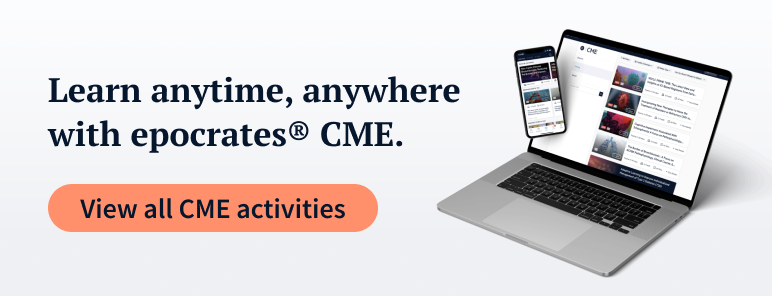
epocrates
How patient-reported outcomes influence medical device development
June 23, 2023

In 2020, The FDA’s Center for Devices and Radiological Health (CDRH) brought together regulators, patients, clinicians, and other key stakeholders to discuss how and where patient reported outcomes (PROs) should be used in developing and deploying medical technology and reported on the outcome of this discussion in its 2022 report. Noting that PRO data is significant for the entire medical device technology lifecycle, from preconception to implementation, the CDRH encouraged the inclusion of clinical outcome assessments in the evaluation of all medical devices.
PROs used in current technology
Today, patient outcomes have been used to guide decision-making in several existing technologies, including:
- Obesity treatment in adults: The FDA approved the Maestro Rechargeable System for obesity in adults. This system uses wire leads and electrodes surgically implanted into the patient's abdomen. The device signals the patient's abdominal vagus nerve, which, in turn, signals to the brain that the stomach is full or empty. The approval process considered patient survey results showing that patients were willing to accept the risks of the implanted device.
- Home hemodialysis: The CDRH recently approved the labeled indication of a home hemodialysis for patients to use alone after a study found that they were prepared to accept the risks of performing the procedure without a caregiver present. Previously, a trained caregiver or partner was required to be present due to severe adverse events that could occur.
- Glucose monitors and insulin pumps for children: Several parents or caregivers of pediatric patients recently reported on their use of glucose monitors and insulin pumps. Their experiences were used to improve product safety in pediatric populations. Using this valuable feedback, a number of medical device companies collaborated with the CDRH to deploy further risk mitigation strategies on devices, including lockout features and prevention of unintended insulin dosing.
- In-office ear infection treatment for children: The Hummingbird Tympanostomy Tube System (TTS) was developed to allow clinicians to insert ear tubes in the office without anesthesia in pediatric patients. This product's development came after the company used patient-reported data to help design the clinical trial. The outcome of this research led to the verification of additional patient benefits when compared to inserting myringotomy tubes in an operating room, including efficiency, patient comfort, no need to fast, and lower overall cost.
Best practices for leveraging PRO data in medical device development
The CDRH recommends the following patient data be used to evaluate new technology, as well as changes to existing technology:
- Patient needs that medical devices are not meeting
- Benefits that are a high priority to patients and risks from a patient perspective
- Tradeoffs of benefits and risks from a patient perspective for specific treatments and diagnostics
- Patient preferences that vary among diverse groups, and their willingness to accept certain benefits and risks
Those living with a particular disease or condition are considered the experts in what life is like with that disease, making their input crucial in developing new devices and how companies measure their success (Webber et al., 2022).
In addition to medical device development, product developers and manufacturers can also use patient-reported data when submitting applications for regulatory approval, evaluating the effectiveness and safety of high-risk devices, and discussing reimbursement and insurance coverage with payors.
Future use of PROs in medical devices and technology
Medical device developers and manufacturers are increasingly collaborating with FDA scientists to develop clinical studies and trials designed to collect patient behaviors, experiences, values, and outcomes related to the use of new and innovative technologies. The data collected helps guide ongoing trials and helps to move these products through the regulatory approval processes. The FDA notes that PROs can aid decision-making and design in the following targeted conditions:
- Parkinson's disease: Patients with early-stage Parkinson's disease were interviewed in a recent study to help understand what experiences and symptoms most significantly impact their daily lives. The study aimed to conceptualize the experience of living with early-stage Parkinson's disease from a patient's experience and identify cardinal symptoms that will be targeted and useful to measure in upcoming clinical trials (Ther et al., 2022).
- Chronic pain: Chronic pain has been studied using patient-reported outcomes for some time. An American Chronic Pain Association survey assessed patients to identify 19 aspects of their lives that were impacted by their symptoms. Researchers then used this information to survey a large population of patients living with chronic pain. The results are further being used to evaluate the effectiveness and efficacy of various treatments (Turk et al., 2008).
- Adolescent scoliosis: Studies have been conducted on various surgical vs. non-surgical interventions for adolescents with severe idiopathic scoliosis. Additional studies have examined the treatment techniques and measured patient quality of life outcomes at different intervals. While PROs have impacted these studies, researchers admit that evidence is lacking on quality of life measures, such as back pain, disability, and cosmetic issues (Bettany-Saltikov et al., 2016).
Patients possess a unique perspective on the use and value of medical devices and technologies. In these and similar conditions, PROs are critical because of the degree to which they can impact and disrupt patients’ and caregivers’ lives. Patients and their caregivers offer significant value when discussing how medical devices impact their health care choices. Likewise, many medical technologists are increasingly eager to implement new technologies and treatments that have the potential to meet patient satisfaction criteria and improve quality of life.
References
Bettany-Saltikov, J., Weiss, H.R., Chockalingam, N., Kandasamy. G., & Arnell, T. (2016, Dec 16). A comparison of patient-reported outcome measures following different treatment approaches for adolescents with severe idiopathic scoliosis: A systematic review. Asian Spine Journal, 10 (6), 1170-1194. https://www.ncbi.nlm.nih.gov/pmc/articles/PMC5165010/.
Food and Drug Administration. (2023, Apr 6). Patient preference information (PPI) in medical decision making. https://www.fda.gov/about-fda/cdrh-patient-science-and-engagement-program/patient-preference-information-ppi-medical-device-decision-making.
Reed, S.D., Yang, J.C., Rickert, T., Johnson, F.R., Gonzalez, J.M., Mentz, R.J., Krucoff, M.W., Vemulapalli, S., Adamson, P.B., Gebben, D.J., Rincon-Gonzalez, L., Saha, A., Schaber, D., Stein, K.M., Tarver, M., & Bruhn-Ding, D. (2022, Jan 15). Quantifying benefit-risk preferences for heart failure devices: A state-preference study. Circulation: Heart Failure, 15 (1). https://www.ahajournals.org/doi/10.1161/CIRCHEARTFAILURE.121.008797.
Ther, N., Cleanthous, S., Andrejack, J., Barker, R.A., Blavat, G., Brooks, W., Burns, P., Cano, S., Gallagher, C., Gosden, L., Siu, C., Slagle, A.F., Trenam, K., Boroojerdi, B., Ratcliffe, N., & Schroeder, K. (2022, Sept 11). Patient experience in early-stage parkinson’s disease: Using a mixed methods analysis to identify which concepts are cardinal for clinical trial outcome assessment. Neurology and Therapy,11, 1319-1340. https://link.springer.com/article/10.1007/s40120-022-00375-3.
Turk, D.C., Dworkin, R.H., Revicki, D., Harding, G., Burke, L.B., Cella, D., Cleeland, C.S., Cowan, P., Farrar, J.T., Hertz, S., Max, M.B., & Rappaport, B.A. (2008). Identifying important outcome domains for chronic pain clinical trials: An IMMPACT survey of people with pain. Pain,137, 276-285. https://www.hsrd.research.va.gov/meetings/sota/pain/All/Turk-Identifying-important-outcome-domains-in-chronic-pain-survey-of-pain.pdf.
Webber, C.M., Caldwell, B., Bocell, F.D., Saha, A., & Tarver, M.E. (2022, May 24). Patient-reported outcomes and medical device evaluation: from conception to implementation. Journal of Patient-Reported Outcomes, 6 (53). https://jpro.springeropen.com/articles/10.1186/s41687-022-00463-w.
Weldring, T. & Smith. S.M.S. (2013, Aug 4). Patient-reported outcomes (PROs) and patient-reported outcome measures (PROMs). Health Services Insights, (6), 61-68. https://www.ncbi.nlm.nih.gov/pmc/articles/PMC4089835/

TRENDING THIS WEEK






